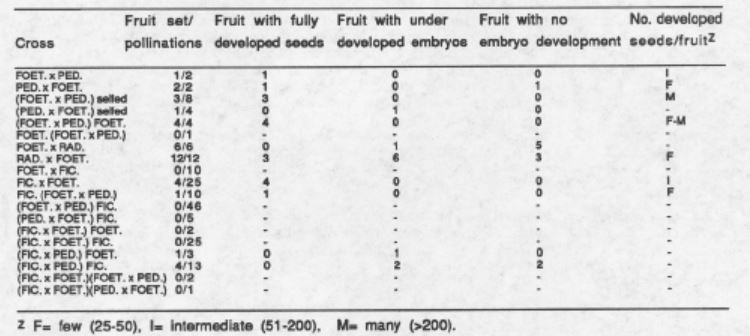Cucurbit Genetics Cooperative Report 10:72-73 (article 37) 1987
Thomas C. Andres
Department of Horticultural Science, New York State Agricultural Experiment Station, Geneva, NY 14456
Cucurbita foetidissima HBK has been regarded as an aberrant species, showing no affinity toward any other Cucurbita species, based on phenetic relationships (4), pollinator species relationships (6), and compatibility relationships (3). Many attempts have been made to hybridize C. foetidissima with other Cucurbita species, but with only limited success. Fruit set was reported in crosses between C. foetidissima and several species, but only by using C. moschata (Duch. ex Lam.) Duch. ex Poir. as the pollen parent were partially developed embryos obtained (3,5). These embryos were cultured and produced vigorous, but sterile plants. Female fertility, however, was restored in the C. foetidissima x C. moschata hybrids by producing amphidiploids (1).
As part of a biosystematic investigation of the genus Cucurbita, two wild xerophytic species, C. pedatifolia Bailey (syn. C. moorei Bailey) and C. radicans Naud. (syn. C. gracilior Bailey), plus one domesticated ombrophilic species, C. ficifolia Bouché, were successfully hybridized with C. foetidissima (Table 1). This is the first report of fully developed interspecific F1 seeds produced by C. foetidissima. Although none of these species were completely cross-compatible with C. foetidissima, F1, F2 and backcross to C. foetidissima progeny were produced in interspecific crosses of C. foetidissima with C. pedatifolia. C. radicans, a species closely related to C. pedatifolia, showed less compatibility with C. foetidissima. All 18 pollinations made between C. radicans and C. foetidissima set fruit, but only a few seeds were fully developed. These latter pollinations, however, were performed at Geneva, NY during the unusually cool, wet summer of 1986 and therefore may be misleading. Most of the other pollinations listed in Table 1 were made during the previous more normal summers.
C. ficifolia hybridized with C. foetidissima only when used as the female parent. The F1 plants were male sterile and possibly also female sterile, since they did not develop any embryos. C. ficifolia may also be hybridized with C. pedatifolia, but again, no subsequent generations were obtained.
C. ficifolia differs from the aforementioned species in having a fibrous, rather than storage-type, root system. C. radicans and C. pedatifolia share the unique ability to produce stolons, or nearly leafless stems, and bear multiple tubers per rooted node; each tuber is 3-4 cm long in C. radicans and 10-15 cm long in C. pedatifolia. Although C. ficifolia, like C. foetidissima, is considered an aberrant species in the genus, it does share a unique morphological character with C. foetidissima, C. pedatifolia, and C. radicans in having pubescent filaments. The remaining species of Cucurbita all have glabrous filaments.
C. foetidissima is of particular interest as a potentially new agronomic crop for arid and semi-arid lands, and a multi-disciplinary team has developed a breeding program to domesticate this species as a source of oil from the seeds, starch from the roots, and forage from the vines (2). Additional sources of germplasm available through interspecific hybridization of C. foetidissima with C. pedatifolia, C. radicans, and C. ficifolia may provide useful genetic traits for this project. For example, heterosis was observed in hybrids between C. foetidissima and C. pedatifolia. C. pedatifolia also has the ability to survive under more extreme xerophytic conditions than C. foetidissima. The potato-size tubers of C. pedatifolia may be more suitable for mechanical harvest than the single huge taproots produced by C. foetidissima.
Table 1. Experimental crosses between C. foetidissima and C. pedatifolia, C. radicans, and C. ficifolia.
Literature Cited
- Bemis, W.P. 1970. Polyploid hybrids from the cross Cucurbita moschata Poir. x C. foetidissima HBK. J. Amer. Soc. Hort. Sci. 95:529-531.
- Bemis, W.P., J.W. Berry and C.W. Weber., 1979. The Buffalo gourd: a potential arid land crop. pp. 65-87. in: New Agricultural Crops. G.C. Ritchie (ed.). Boulder, Colorado: Westview Press.
- Bemis W.P. and J.M. Nelson. 1963. Interspecific hybridization within the genus Cucurbita I., fruit set, seed set and embryo development. J. Ariz. Acad. Sci. 2:104-107.
- Bemis, W.P., C.M. Rhodes, T.W. Whitaker, and S.G. Carmer. 1970. Numerical taxonomy applied to Cucurbita relationships. Amer. J. Bot. 57:404-412.
- Grebenscikov, I. 1958. Ober zwei Cucurbita-Artkreuzungen. Züchter 28:233-237.
- Hurd, P.D., E.G. Linsley, and T.W. Whitaker. 1971. Squash and gourd bees (Peponapis, Xenoglossa) and the origin of the cultivated Cucurbita. Evolution 25:218-234.
